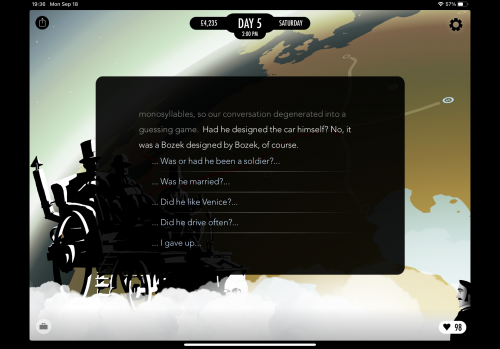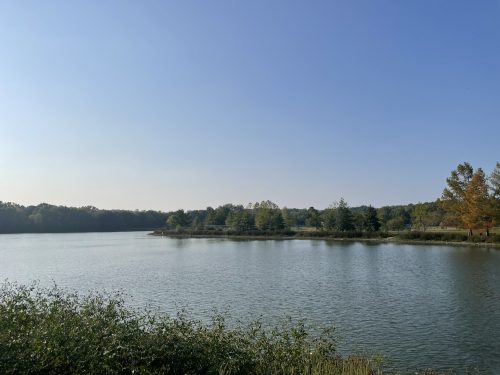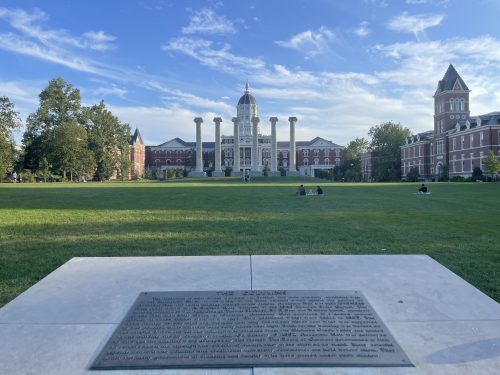Level 2 Blog: The World of Play

The second section of the learning journey in the Why So Serious Game Academy (WSSGA) has been becoming more dramatic and challenging. I have been playing my second mentor game, “80 days”, while exploring the “skeleton” of a good game. Where is the skeleton as the foundation of a good game located in? The answer is “a good story”. And then, what is the inner core of a good story? The answer is “a good idea”. Just like the game “80 days”, I have been playing over these days. Jules Verne had a good idea to set a Great Britain Gentleman to travel around the world in 80 days. Developed on this idea, his novel (story) Around the World in Eighty Days was first published in French in 1872 and became popular and famous. Then based on the novel (story), uncountable related learning materials and games were yielded. Even after over 150 years, Jules Verne’s unique idea still shines. “Most of the students in a study reported that not only did their knowledge of the world increase after completing a course assignment but that their interest in the discipline increased as well by using the National Geography Standards in the context of Jules Verne’s Novel”(Donaldson & Kuhlke, 2009). The mentor game 2 I selected, 80 days, won a lot of awards, e.g., TIME Game of 2014, IGF Award for Narrative Excellence, IMGA Award for Narrative…It was released by Inkle for iOS platforms on July 31, 2014 (80 Days, 2018).
“When forced to work within a strict framework, the imagination is taxed to its utmost—and will produce its richest ideas. Given total freedom the work is likely to sprawl.” —- T.S. Eliot
Where can I find my good ideas like Verne’s? That was the first question that jumped out of my brain when I was asked to design my own educational game in WSSGA level 2. Annakaisa Kultima gave me valuable suggestions based on her 23 interviews with Finnish game designers and professionals. Her suggestions were “reading, watching television shows and movies, or, not that surprisingly, playing other games”(Kultima, n.d.). I loved the suggestions and followed them in the past several weeks. Besides those games on the WSSGA level 2, I played educational games about water science at Adroit Studios at the School of Information Science and Learning Technologies, I played a card game about the bureaucratic system of the US at a workshop led by the faculties from Teaching for Learning Center, I read Dr. Victoria L. Mondelli’s new book The Allure of Play: The Educator’s Guide to Design Games and Creative Active-Learning Exercises, I reread Robert McKee’s classical book Story, and I finished reading the Chapter 7: Applying Gamification to Problem-Solving of Karl Kapp’s The Gamification of Learning and Instruction… If given more time, I would prefer to read more and not start to design my story to align with the 11 parameters for designing a game to teach problem-solving. Even they have stayed in my mind for a while. T.S. Eliot is right when he said, “When forced to work within a strict framework, the imagination is taxed to its utmost—and will produce its richest ideas. Given total freedom the work is likely to sprawl.”
Indeed, if given the fictional protagonist Phileas Fogg forever but not 80 days to travel the world, most possibly, Mr. Fogg would not set off yet, and Verne’s good idea would not have a chance to be developed to a great story, and the following distinguished establishments both in literature and in gamification. The deadlines and constructive learning progression in WSSGA helped me turn my creative stream into a river. And the protagonist in my narrative game has been floating up gradually.
“Tell me and I forgot, teach me and I may remember, involve me and I learn.” —- Benjamin Franklin
I am so lucky to have Dr. Oprean and Nicholas as my mentors and learning models when I was learning how to design games for learning. We three formed a team to design another educational game outside of WSSGA about energy and the environment, which paralleled my learning journey at WSSGA. I obtained more opportunities from this lovely team to practice the theories I learned into practice.
The tools of collaboration and designing they used to push teamwork forward efficiently impressed me and showed me how to design an educational game more professionally. I have not been learning by reading; instead of that, I have been learning by doing in the team. It was a great experience for me to borrow similar working philosophies from the team project to my personal game design.
Dr. Oprean Listed all the strategies for writing a good story and let Nicholas and I evaluate each of them, improve them, and polish the story. Besides that, the weekly meetings always went along with extra readings, which enhanced my understanding of educational games. During the process of designing my game, the criteria for what qualifies as a solid game narrative(Berger, n.d.) helped me a lot:
- Are the story milestones exciting and/or compelling?
- Is the character development organic and gradual?
- Does the narrative have a relationship to the gameplay, or is it independent of it? To what degree is the latter? Do the actions from the narrative have consequences on the gameplay? Does the gameplay have consequences on the narrative?
- Is the narrative frictionless? Or is the fun being interrupted too many times in order for me to follow a story that is not interesting?
- Does the story fit with the rest of the game? Is it tonally consistent? Is the pacing consistent?
- Most importantly, am I emotionally invested?
I can’t agree more with Annakaisa Kultima’s point, “The game ideas arise from solitude and mature by bouncing” (Kultima, n.d.). At the very beginning of my game design, there was only a blight and blurred thought that I wanted to design a game that could help more students like me as a new resident in Columbia, Missouri. After giving up several initial ideas, I decided to ride my bicycle to the MKT trait, a famous natural trait that can lead you along from downtown Columbia to the Missouri River.

On my way back to the campus, a panel on the roadside grabbed my attention. The panel told me a hidden history of the bridge ahead of me,” Near this place James T. Scott, a Black janitor in the medical school at MU, was killed on April 29th, 1923. A mob brought Mr. Scott to the bridge, place a noose around his neck, and pushed him over the railing while hundreds of spectators watched…The Lynching at Stewart Road Bridge reminds us of how far we have come and the work we have yet to do (Lest We Forget, n.d.).” Nobody told me about this, I thought. If I could collect more hidden histories about the campus and design them in a game, it would allow the players to learn more knowledge about Mizzou’s history in a gamification way. Then, I went back to my apartment to write down the draft of my game story. If I had to repeat this process, I wish I had started to write my first draft earlier and focused on what I was most concerned about.
A beautifully told story is a symphonic unity in which structure, setting, character, genre, and idea meld seamlessly. To find their harmony, the writer must study the elements of story as if they were instruments of an orchestra—first separately, then in concert. —-Robert McKee
Here is the first draft of my game
Title: The Hidden Map of MU
Story summary: Even if you believe that you are so familiar with the University of Missouri, Columbia campus, there are some places or hidden histories you may not know. So, this educational game The Hidden Map of MU, is designed for you and other new students at MU. The player will have a fantastic “campus exploration” to travel between different times in history and places on campus. The player will be involved in firefighting to witness the origin of “the Columns (Links to an external site).” and try to stop a lynching at the Stewart Road Bridge (Links to an external site.), talk with Thomas Jefferson, whose family gave his original tombstone (Links to an external site). to MU, a grumpy senior man will talk to the player about his understanding about education after he got his honor Doctoral Degree of Laws, the senior man has a written name, Mark Twain (Links to an external site). Mort Walker (Links to an external site). is in his 20s to chat with the player about his comic dream… The style of the game will be similar to the movie Midnight in Paris.(Links to an external site).
Learning goal: This game is designed for all the learners who want to know more about Mizzou, especially for the new MU students. The gamification learning journey aims to familiarize the learners with the knowledge about the MU campus and increase learners’ interest in MU history, including fun facts.
Learning Objectives:
- By the end of this game, the players will be able to discuss with their friends three or more hidden history stories of MU.
- By the end of this game, the players will be able to support human rights.
- By the end of this game, the players will be able to evaluate the value of learning.
Setting: The players will travel on MU’s campus. Check the history details as a new MU student. The historical figures and scenes will keep their own traits in history. Players will act as a time traveler to visit the famous places and people.
Plot: In the Fall of 2023, a new MU graduate student Yupei enroll in MU. This is his first year both in MU and the US. Yupei struggling to get used to the new life and finds himself drawn to the rich history of MU. By chance, he witnesses the big fire in the Academic Hall, and a lynching at the Stewart Road Bridge, he talks with Thomas Jefferson and other famous people related to MU. During the process of his time travel, a lot of historical details will be shown. Back to real life, Yupei becomes more familiar with MU. He is new but knowledgeable about MU who can help more people to know MU’s hidden history.
Conflict: Yupei’s as a new resident in Columbia, Missouri, is embarrassed in a lot of areas. The Hidden Map of MU makes him more confident. Yupei talks with Thomas Jefferson, Mark Twain, and Mort Walker about the value of learning, the difference between schooling and education, the difference between a degree and an experience, the difference between spiritual abundance and wealth…
Resolution: Conclusion of the story: The story encourages the new MU students to explore the campus and their lives bravely and actively. The story aims to remind all the learners how to make choices in their ordinary and academic lives, shares a chance for the players to ponder what they want and need, and tells the players that the different possibilities in our lives are based on our choices.
The branches:
- Wealth v.s. Spiritual abundance
- A degree v.s. An experience
- Schooling v.s. Education
The feedbacks I received:
Commenter A: I would like to see further developed for your final submission is the story that guides this exploration. Twine (and even Scratch) are narrative driven, so facts with reading, and dialogue with various characters are the primary way to interact with the game. This leads to a need to generate a storyline foundation that will allow for players to explore but to also have a sense of purpose…The focus now should be on really defining the learning so you can make sure your design addresses it for your final submission. In prototyping, you don’t have to build the entire game, only the major story parts to see if the game design works without all of the details.
Commenter B: While the concept is fascinating, the story summary is somewhat vague in terms of how gameplay mechanics will work. More details on how players will interact with history and complete objectives could provide a clearer picture of the game. I think you’re on point with the firefight. But what activities could be included as interactions with the historical figures? What actions can be taken that are relevant to the content?
Commenter C: As an online student not living in or from Missouri, I love the idea for your game. Also, the title fits quite well with the game’s premise. Your story see …
Commenter D: What did you like/dislike about the story and title? (Remember be kind, we are all learning here!) I love this concept. I am really into history so I think this is …
Commenter E: It sounds like we’re facing similar uncertainties with complexity and Twine. It’s still intriguing to think about the possibilities. I will definitely check your game out!
Let my story continue; let the game continue…

References:
80 Days. (2018, January 30). App Store. https://apps.apple.com/cg/app/80-days/id892812659
Berger, R. (n.d.). Dramatic Storytelling & Narrative Design: A Writer’s Guide to Video Games and Transmedia.
Donaldson, D. P., & Kuhlke, O. (2009). Jules Verne’s Around the World in Eighty Days: Helping Teach the National Geography Standards. Journal of Geography, 108(2), 39–46. https://doi.org/10.1080/00221340902945958
Kultima, A. (n.d.). The organic nature of game ideation: Game ideas arise from solitude and mature by bouncing.
Lest We Forget: Lynching at the Stewart Road Bridge Historical Marker. (n.d.). Retrieved September 28, 2023, from https://www.hmdb.org/m.asp?m=169415
